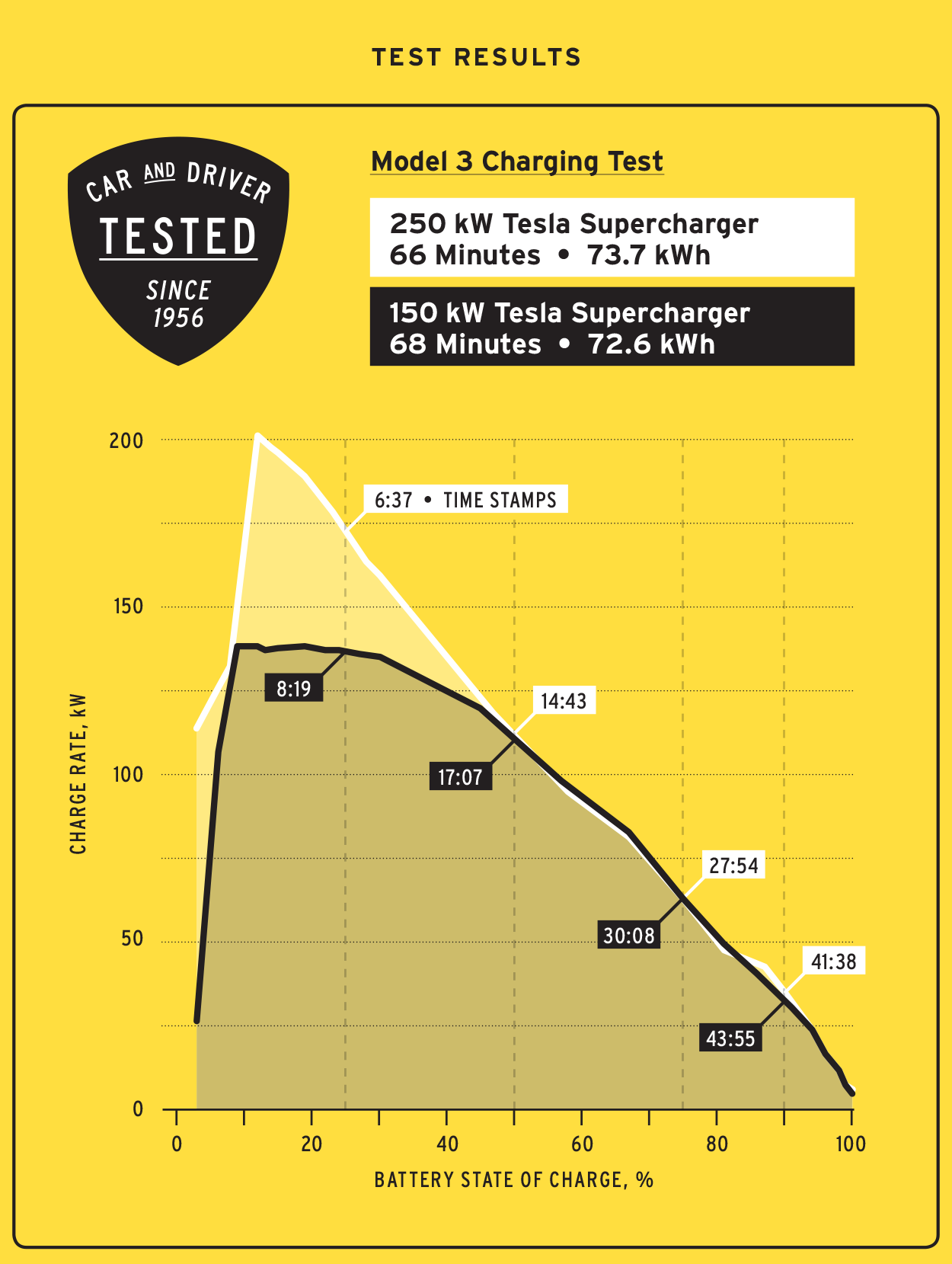I just had to use it yet again in September. Tesla still hasn't connected the 255 mile gap between Winnemucca, NV and Boise, ID. It's a giant pain in the butt.TBH though... i have yet to see a routing which would be doable with CCS but not doable with the Supercharger network here in the US.
Welcome to Tesla Motors Club
Discuss Tesla's Model S, Model 3, Model X, Model Y, Cybertruck, Roadster and More.
Register
Install the app
How to install the app on iOS
You can install our site as a web app on your iOS device by utilizing the Add to Home Screen feature in Safari. Please see this thread for more details on this.
Note: This feature may not be available in some browsers.
-
Want to remove ads? Register an account and login to see fewer ads, and become a Supporting Member to remove almost all ads.
You are using an out of date browser. It may not display this or other websites correctly.
You should upgrade or use an alternative browser.
You should upgrade or use an alternative browser.
theothertom
Member
Yep. I looked at a route from South Carolina to Houston that we take 3-4 times a year. There are some inconvenient superchargers that we could skip and use a CCS if we had the adapter.Sometimes there is a convenient CCS station where you are already stopping but you would have to go out of your way to a Supercharger.
texas_star_TM3
Active Member
problem is that V3 SC's will go to 250kw top charging speeds whereas the CCS test in Canada maxed out around 100kw... in the best case the CCS adapter will deliver you speeds of a really slow V2 SC...There is a big difference between "doable" and "convenient". Sometimes there is a convenient CCS station where you are already stopping but you would have to go out of your way to a Supercharger.
SageBrush
REJECT Fascism
problem is that V3 SC's will go to 250kw top charging speeds whereas the CCS test in Canada maxed out around 100kw... in the best case the CCS adapter will deliver you speeds of a really slow V2 SC...
The point here is to have choices and options. You are not expected to marry a network. You will not be accused on infidelity -- promise.
problem is that V3 SC's will go to 250kw top charging speeds whereas the CCS test in Canada maxed out around 100kw... in the best case the CCS adapter will deliver you speeds of a really slow V2 SC...
Given that you're stopped at a place that has CCS but no SC in this scenario, 100 kW is infinity times faster than a 250 kW charger that doesn't exist. Opposite of a problem!
e of pi
Member
problem is that V3 SC's will go to 250kw top charging speeds whereas the CCS test in Canada maxed out around 100kw... in the best case the CCS adapter will deliver you speeds of a really slow V2 SC...
To pull a 50% Model 3 LR charge, you need...what, 40 kWh? So at 250 kW, that'd take 9.6 minutes. At 110 kW, that's take 21 minutes. If you can avoid going 15 minutes out of your way to get to the "slow" CCS charger, you've saved 5 minutes on net. Moreover, you're not going to be at 250 kW the whole session in reality, due to the charging curve. That means the savings of being on the 250 kW charger will be less than the "nominal" 11 minute savings--maybe more like 7-8 minutes. If it's closer to your route, enables a faster routing, or allows a cheaper session (like EA's free charging in at least CA and the northeast over this Thanksgiving), it could be worth it.

Tesla's 250-kW Supercharger Only Saved Us 2 Minutes vs. a 150-kW Charger

SageBrush
REJECT Fascism
But, but ... what about L1 ?Given that you're stopped at a place that has CCS but no SC in this scenario, 100 kW is infinity times faster than a 250 kW charger that doesn't exist.
I doubt that CCS place with Tesla adapter is much more than 80x faster.
miimura
Well-Known Member
We don't actually know the top charging speed of the CCS adapter yet. However, anything faster than Urban Supercharger speed (200A+) is definitely useful to have.problem is that V3 SC's will go to 250kw top charging speeds whereas the CCS test in Canada maxed out around 100kw... in the best case the CCS adapter will deliver you speeds of a really slow V2 SC...
SageBrush
REJECT Fascism
However, anything faster than Urban Supercharger speed (200A+) is definitely useful to have.
Anything CHAdeMO speed or faster is useful to me, simply because CCS is already much more reliable and distributed than CHAdeMO. But whatever. I plan to have both CHAdeMO and CCS adapters with me when I travel, in addition to a packet of L2 adapters.
And if I am lucky, I won't use any of them.
Last edited:
miimura
Well-Known Member
I actually agree with you that the 125A of the CHAdeMO adapter is useful. The guy was complaining that it wasn't 250kW, so my "definitely useful" level set a slightly higher bar.Anything CHAdeMO speed or faster is useful to me, simply because CCS is already much more reliable and distributed than CHAdeMO. But whatever. I plan to have both CHAdeMO and CCS adapters with me when I travel, in addition to a packet of L2 adapters.
And if I am lucky, I won't use any of them.
Well, the overall reliability of CCS charging is subject to some doubt - I have seen reports of lots of chargers simply not working - in various different ways and for various different reasons - even for EVs which incorporate native CCS charging. There are a lot of versions of CCS chargers out there and specific versions on a given day sometimes work or don't work with different vehicles, if they are up and running at all.Anything CHAdeMO speed or faster is useful to me, simply because CCS is already much more reliable and distributed than CHAdeMO. But whatever. I plan to have both CHAdeMO and CCS adapters with me when I travel, in addition to a packet of L2 adapters.
And if I am lucky, I won't use any of them.
Experience with the Setec product indicates that things often get worse using a CCS adapter with a Tesla, as various different versions of the adapter firmware and, in some instances, the Tesla vehicle software, can affect whether an otherwise functional CCS charger will work with the vehicle. Perhaps a Tesla-branded CCS adapter will overcome this aspect of the reliability issue, but this will not necessarily be the case.
I do plan to get the Tesla CCS adapter myself, if and when it becomes available in North America, but I don't expect it to be as reliable as native Tesla charging. I do hope that overall reliability will improve as time progresses and the technology becomes more standardized and advanced.
SageBrush
REJECT Fascism
I actually agree with you that the 125A of the CHAdeMO adapter is useful.
Yep !
I was in Colorado's Supercharger desert not too long ago and had to make do with L2 charging. I was delighted to find a (autographed by Elon, no less) TWC at 9.6 kW I could use instead of the fairly common 6 kW EVSE around. Shaving more than 50% of charging time was very welcome. CHAdeMO is ~ 4x faster than the TWC, or about 7x faster than garden variety L2.
Does it stink compared to a Tesla Supercharger of any variety, let alone V3 ? Sure. But ymmv for what is available, and I still run around in places where CHAdeMO level DC charging is nothing to complain about.
jsight
Active Member
To pull a 50% Model 3 LR charge, you need...what, 40 kWh? So at 250 kW, that'd take 9.6 minutes. At 110 kW, that's take 21 minutes. If you can avoid going 15 minutes out of your way to get to the "slow" CCS charger, you've saved 5 minutes on net. Moreover, you're not going to be at 250 kW the whole session in reality, due to the charging curve. That means the savings of being on the 250 kW charger will be less than the "nominal" 11 minute savings--maybe more like 7-8 minutes. If it's closer to your route, enables a faster routing, or allows a cheaper session (like EA's free charging in at least CA and the northeast over this Thanksgiving), it could be worth it.

Tesla's 250-kW Supercharger Only Saved Us 2 Minutes vs. a 150-kW Charger

I used to use an EA site with a chademo adapter for this reason. It sure beat a 20+ minute detour, even with only ~45kw charging rates. I rarely needed more than ~15% anyway.
Almost certainly the Tesla CCS adapter will be far more reliable than the Setek - which emulate's the Tesla CHAdeMO adapter to the car.Experience with the Setec product indicates that things often get worse using a CCS adapter with a Tesla, as various different versions of the adapter firmware and, in some instances, the Tesla vehicle software, can affect whether an otherwise functional CCS charger will work with the vehicle. Perhaps a Tesla-branded CCS adapter will overcome this aspect of the reliability issue, but this will not necessarily be the case.
That said, there's enough reported weirdness with various other EVs and CCS chargers that it almost certainly will not be as reliable as Supercharging which just works unless there's a physical problem with the Supercharger.
brkaus
Well-Known Member
I’ve used the chademo several times on a road trip to a specific location, but Tesla put a supercharger up the street from the one I needed. So that’s all good now.
I’d probably pay $500 to upgrade my car, just to reduce the risk of holiday charging jams.
I’d probably pay $500 to upgrade my car, just to reduce the risk of holiday charging jams.
Every owner can do it himself, pretty same as replace memory in laptop. + update car after.yeah... I'm a bit bummed that once they release the adapter... pre 2020 (?) Model 3s (which are a large amount) will need a retrofit before being able to charge CCS. hopefully the Mobile Ranger can do the retrofit (?) and it won't cost an arm and a leg.
TBH though... i have yet to see a routing which would be doable with CCS but not doable with the Supercharger network here in the US.
SageBrush
REJECT Fascism
And then expect Tesla to cover the cost of any damages when the owner does something stupid.Every owner can do it himself, pretty same as replace memory in laptop. + update car after.
phigment
Member
Cool, can you point out the instructions? I wouldn't know where to start.Every owner can do it himself, pretty same as replace memory in laptop. + update car after.
Xelloss99
Member
The service manual has it.Cool, can you point out the instructions? I wouldn't know where to start.
Open the trunk, and remove the left hand trim inside the trunk (inside where the charge port is). The ECU is mounted by the charge port on the wheel well.
Disconnect 12V power from the car
Disconnect the 3 connectors from the ECU.
Remove the one bolt that holds the ECU to the body and slide it to the right to remove it.
Then install the new ECU and reverse the process.
Similar threads
- Replies
- 3
- Views
- 371
- Replies
- 4
- Views
- 1K
- Replies
- 4
- Views
- 841


